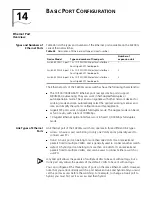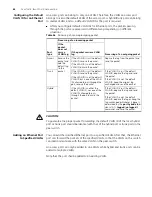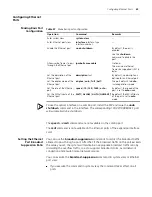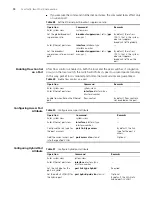
80
C
HAPTER
15: L
INK
A
GGREGATION
C
ONFIGURATION
When creating an aggregation group:
■
If the aggregation group you are creating already exists but contains no port, its
type will change to the type you set.
■
If the aggregation group you are creating already exists and contains ports, the
possible type changes may be: changing from dynamic or static to manual, and
changing from dynamic to static; and no other kinds of type change can occur.
■
When you change a dynamic/static group to a manual group, the system will
automatically disable LACP on the member ports. When you change a
dynamic/static group to a manual group, the system will remain the member ports
LACP-enabled.
When adding Ethernet ports to an aggregation group:
■
You cannot add the following types of ports into an aggregation group: mirroring
port, port with static MAC address configured, port with static ARP configured,
port with 802.1x enabled.
■
When a manual or static aggregation group contains only one port, you cannot
remove the port unless you remove the whole aggregation group.
Configuring a Static
LACP Aggregation
Group
You can create a static LACP aggregation group, or remove an existing static
aggregation group (after that, the system will re-aggregate the original member ports
in the group to form one or more dynamic aggregation groups.).
You can manually add/remove a port to/from a static aggregation group, and a port
can only be manually added/removed to/from a static aggregation group.
When you add an LACP-enabled port to a manual aggregation group, the system will
automatically disable LACP on the port. Similarly, when you add an LACP-disabled
port to a static aggregation group, the system will automatically enable LACP on the
port.
Configure a description for
the aggregation group
link-aggregation
group
agg-id
description
agg-name
Optional
By default, an
aggregation
group has no
description.
Enter Ethernet port view
interface
interface-type interface-num
—
Add the port to the
aggregation group
port link-aggregation group
agg-id
Required
Table 59
Configure a manual aggregation group (Continued)
Operation
Command
Description
Table 60
Configure a static LACP aggregation group
Operation
Command
Description
Enter system view
system-view
—
Create a static aggregation
group
link-aggregation group
agg-id
mode
static
Required
Configure a description for the
aggregation group
link-aggregation
group
agg-id
description
agg-name
Optional
By default, an
aggregation group has
no description.
Enter Ethernet port view
interface
interface-type
interface-number
—
Summary of Contents for 4200G 12-Port
Page 10: ...8 CONTENTS...
Page 14: ...4 ABOUT THIS GUIDE...
Page 46: ...32 CHAPTER 5 LOGGING IN THROUGH WEB BASED NETWORK MANAGEMENT SYSTEM...
Page 48: ...34 CHAPTER 6 LOGGING IN THROUGH NMS...
Page 60: ...46 CHAPTER 9 VLAN CONFIGURATION...
Page 64: ...50 CHAPTER 10 MANAGEMENT VLAN CONFIGURATION...
Page 80: ...66 CHAPTER 13 GVRP CONFIGURATION...
Page 98: ...84 CHAPTER 15 LINK AGGREGATION CONFIGURATION...
Page 112: ...98 CHAPTER 18 MAC ADDRESS TABLE MANAGEMENT...
Page 126: ...112 CHAPTER 19 LOGGING IN THROUGH TELNET...
Page 162: ...148 CHAPTER 20 MSTP CONFIGURATION...
Page 274: ...260 CHAPTER 29 IGMP SNOOPING CONFIGURATION...
Page 276: ...262 CHAPTER 30 ROUTING PORT JOIN TO MULTICAST GROUP CONFIGURATION...
Page 298: ...284 CHAPTER 33 SNMP CONFIGURATION...
Page 304: ...290 CHAPTER 34 RMON CONFIGURATION...
Page 338: ...324 CHAPTER 36 SSH TERMINAL SERVICES...
Page 356: ...342 CHAPTER 38 FTP AND TFTP CONFIGURATION...
Page 365: ...Information Center Configuration Example 351 S4200G terminal logging...
Page 366: ...352 CHAPTER 39 INFORMATION CENTER...
Page 378: ...364 CHAPTER 40 BOOTROM AND HOST SOFTWARE LOADING...
Page 384: ...370 CHAPTER 41 Basic System Configuration and Debugging...
Page 388: ...374 CHAPTER 43 NETWORK CONNECTIVITY TEST...
Page 406: ...392 CHAPTER 45 CONFIGURATION OF NEWLY ADDED CLUSTER FUNCTIONS...
















































